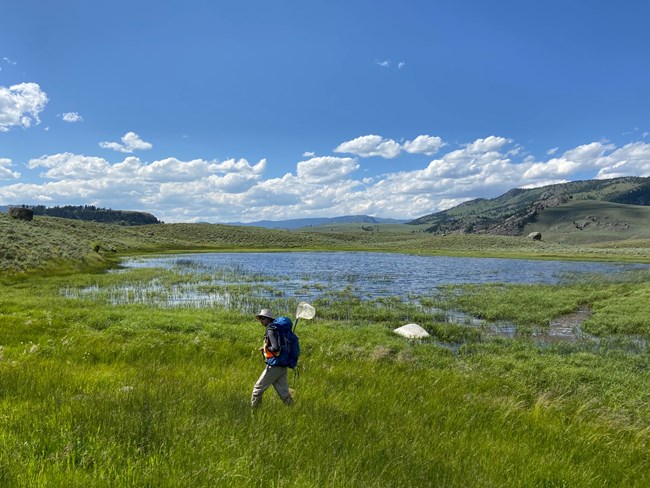
NPS Photo
Amphibians need water for breeding and the development of their young. But wetlands around the world are ranked among the habitats most threatened by climate change. The loss of wetlands, not surprisingly, coincides with the decline of organisms, like amphibians, that depend on them. Amphibians also alert us to other kinds of changes that negatively affect them, such as disease, pollution, and nonnative species. Because they can serve as indicators of park health and alert us to deteriorating conditions, we monitor amphibians as a vital sign.
A variety of stressors affect amphibians. Globally, amphibians are affected by disease, including Ranavirus and the chytrid fungus (Batrachochytrium dentrobatidis). These two disease agents are widespread across Yellowstone and Grand Teton national parks. Pollution is another potential stressor. While the effects of pollution on amphibians can be complicated, wetlands that collect runoff from roads and developed areas in the parks may be most vulnerable.
Since 1950, air temperature in the Greater Yellowstone Area has been rising. Simultaneously, wetland flooding patterns have changed and some wetlands have completely dried out. Since 2006 we have been collecting data each year from approximately 300 wetlands across Yellowstone and Grand Teton national parks. Our results show a change in the number of wetlands available for wetland-dependent species, including waterfowl. We found that in hot, dry years (e.g., 2007), upwards of 40% of the parks' wetlands dry up by early to midsummer. In cool, wet years (e.g., 2011), most wetlands in the parks are flooded and available for amphibian breeding. Annual changes in air temperature, precipitation, and snowmelt—its timing and amount—clearly affect wetlands. Projections are for a warmer, drier climate in this region. If that occurs, the resulting loss of wetlands could lead to a future decline in breeding amphibians.
Grand Teton and Yellowstone national parks are home to five native amphibians: the Columbia spotted frog (Rana luteiventris), boreal chorus frog (Pseudacris maculata), western tiger salamander (Ambystoma mavortium), western toad (Anaxyrus boreas), and plains spadefoot (Spea bombifrons). Since 2005, we have been collaborating with other scientists to monitor these species and their wetland habitats. Our partners include federal agencies, universities, and nongovernmental organizations. The information we gather also feeds into Rocky Mountain region and national monitoring results tied to the Amphibian Research and Monitoring Initiative, as well as a 2024 updated and verified list of amphibian species in national park units across the United States.
Our overall goal is to track changes in amphibian breeding populations and habitat.
We Ask:
- How are wetland flooding conditions changing?
- Are a greater percentage of monitored wetlands dry each year?
- What weather conditions are associated with wetland drying?
- Are the number of watersheds used by native amphibians for breeding changing?
- Are the number of wetlands used by native amphibian for breeding changing?
- Are breeding dynamics (who breeds; number of young produced) consistent across species or do they vary?
We Measure:
- the number and habitat characteristics of potentially suitable amphibian breeding sites in monitored watersheds
- the presence and breeding characteristics of native amphibian species at all wetlands
View the protocol for monitoring this vital sign.
View the science review of the Greater Yellowstone Network amphibian protocol in 2020.
Last updated: June 12, 2025
